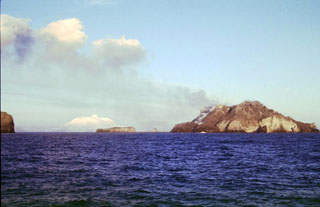Report on McDonald Islands (Australia) — December 2004
Bulletin of the Global Volcanism Network, vol. 29, no. 12 (December 2004)
Managing Editor: Richard Wunderman.
McDonald Islands (Australia) Thermal anomaly detected on 14 November 2004
Please cite this report as:
Global Volcanism Program, 2004. Report on McDonald Islands (Australia) (Wunderman, R., ed.). Bulletin of the Global Volcanism Network, 29:12. Smithsonian Institution. https://doi.org/10.5479/si.GVP.BGVN200412-234011
McDonald Islands
Australia
53.03°S, 72.6°E; summit elev. 230 m
All times are local (unless otherwise noted)
The first ever MODVOLC thermal anomaly at the McDonald Island volcano was detected on 14 November 2004. The anomaly, one pixel in size, was located directly over the island. There have been none since then through 13 January 2005, nor have there been any other obvious false-alert pixels in the vicinity, suggesting that this anomaly was genuine.
Andrew Tupper investigated the above-mentioned anomaly (on a Terra MODIS image, overpass time 1827 UTC, 14 November 2004; seen in bands 20-25 (3.8-4.5 um)). Basically, the anomaly occurred within 2 km of the location of the summit coordinates given in the title above. Tupper went on to note: "I've looked at other MODIS images from around that time, and some recent AVHRR images, but it is extremely difficult to get a cloud-free shot of that area. There are no other hot spots visible, and no volcanic plumes visible, but unless there was a bonfire lit by a stranded party of toothfish poachers at the time, I can't think of any reason to doubt that the hot-spot is volcanic."
Geological Summary. Historical eruptions have greatly modified the morphology of the McDonald Islands, located on the Kerguelen Plateau about 75 km W of Heard Island. The largest island, McDonald, is composed of a layered phonolitic tuff plateau cut by phonolitic dikes and lava domes. A possible nearby active submarine center was inferred from phonolitic pumice that washed up on Heard Island in 1992. Volcanic plumes were observed in December 1996 and January 1997 from McDonald Island. During March 1997 the crew of a vessel that sailed near the island noted vigorous steaming from a vent on the N side of the island along with possible pyroclastic deposits and lava flows. A satellite image taken in November 2001 showed the island to have more than doubled in area since previous reported observations in November 2000. The high point of the island group had shifted to the McDonald's N end, which had merged with Flat Island.
Information Contacts: Matt Patrick, Luke Flynn, Harold Garbeil, Andy Harris, Eric Pilger, Glyn Williams-Jones, and Rob Wright, HIGP Thermal Alerts Team, Hawai'i Institute of Geophysics and Planetology (HIGP) / School of Ocean and Earth Science and Technology (SOEST), University of Hawai'i, 2525 Correa Road, Honolulu, HI 96822, USA (URL: http://modis.higp.hawaii.edu/); Andrew Tupper, Darwin Volcanic Ash Advisory Centre (VAAC), Commonwealth Bureau of Meteorology, Northern Territory Regional Office, PO Box 40050, Casuarina, NT 0811, Australia (URL: http://www.bom.gov.au/info/vaac/).

